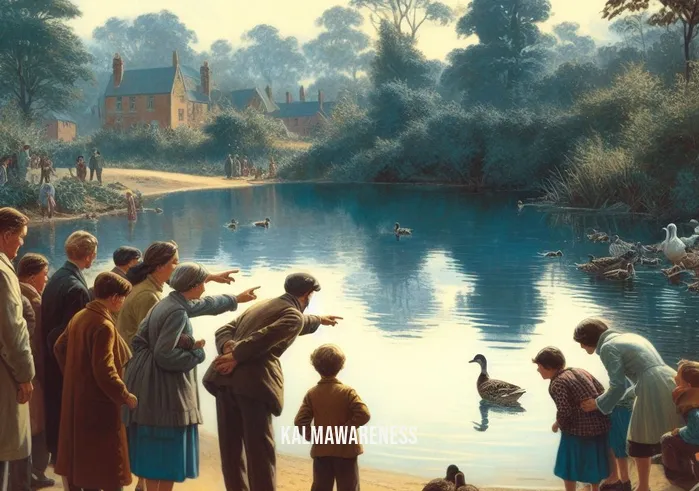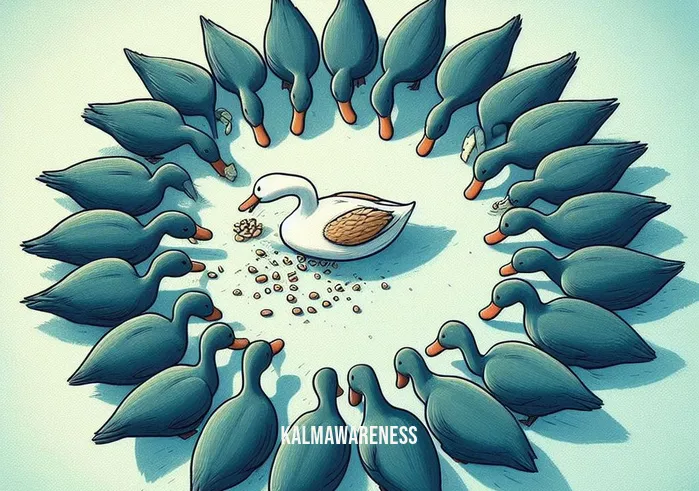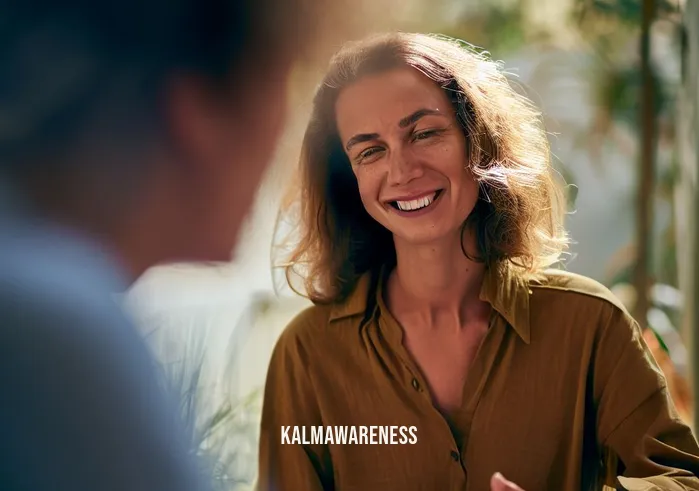The Intricacies of a Judgemental Duck: A Dive into Animal Behavior and Human Parallels
Ducks, known for their playful splashes and endearing waddles, have become a symbol of innocence and purity in many cultures. But what if, among these docile beings, there lurked a judgemental duck? One that, against all odds, showcased traits eerily reminiscent of human social behavior? As surprising as it may sound, studying the underlying psychology and social patterns of such a duck offers profound insights into our own behaviors, communication tendencies, and emotional triggers.
Unraveling the Mysteries of Habitual Thinking
While it might seem odd to think of a duck ensnared in habitual thinking, the reality isn’t too far fetched. Just as humans develop routines and patterns based on their past experiences and inherent instincts, animals too display predictable behaviors. It’s essential to differentiate between instinctual behavior and those born out of experience. For instance, a judgemental duck might have had interactions that taught it to be wary or judgmental of specific stimuli, much like how humans develop biases.
Listening: A Lost Art in Both Humans and Ducks?
You might laugh at the idea, but ducks, much like humans, communicate in multitudinous ways. From their vocal quacks to subtle body language, they’re constantly ‘talking’. And, just like in human interactions, not every duck is an attentive listener. The practice of mindless listening is not just a human flaw. A judgemental duck, with its preconceived notions, may choose to ignore certain signals from its peers, leading to miscommunication and strained duck relationships.
Mindfulness: The Path to Understanding
The solution to breaking barriers in communication and understanding, both for our judgemental duck and for humans, lies in mindful conversation. It’s about being present in the moment, truly hearing out the other party, and responding with empathy. This not only applies to verbal discussions but also to how we interpret non-verbal cues in animals. By taking a leaf out of the book on mindful dog training, we can understand the importance of mutual respect and patience in fostering healthy relationships, whether it’s between humans or between a human and a duck.
The Psychology Behind Judgement
Now, let’s address the elephant (or should I say, duck?) in the room. Why would a duck, of all creatures, be judgemental? To answer this, we need to delve into the world of animal psychology and, by extension, human psychology. Animals, much like humans, have distinct personalities. The fascinating exploration of inside-out personality types highlights how external stimuli and internal factors interplay to shape one’s behavior. Similarly, a duck might have its own set of experiences, memories, and learned behaviors that make it judgemental.
Moreover, the intricate relationship between the mind and the brain sheds light on neuroplasticity and how experiences can shape cognitive patterns. In simpler terms, just as humans can change and adapt based on experiences, so can our feathered friends.
Bridging the Gap
By now, you might wonder, “Why should I care about a judgemental duck?” Beyond the novelty, it serves as a mirror reflecting our own biases, communication flaws, and habitual patterns. The parallels between animal behavior and human tendencies offer a unique lens through which we can introspect and grow.
In the realms of understanding behavior and socialization, both for ducks and humans, lies a vast sea of wisdom. Just as personal growth seminars guide individuals on self-improvement journeys, understanding the judgemental duck provides a similar roadmap.
To comprehend this topic fully and uncover the underlying mysteries of communication, behavior, and social intricacies, continue reading. In the next segment, we will delve deeper into the realm of animal behavior, shedding light on how it mirrors human interactions and what lessons we can imbibe from our judgemental duck. Join us on this enlightening journey!

Understanding the Layers of a Judgemental Duck: Beyond the Surface
While the first chapter unveiled the parallel universe of human and duck behaviors, it’s crucial to delve deeper to understand the layers beneath the façade of a judgemental duck. What makes a duck display traits that we, as humans, often attribute to complex cognitive beings? Let’s untangle the mysteries.
Subtle Signs of a Discerning Duck
Ducks might seem straightforward creatures, but beneath their playful demeanor, they communicate complex emotions. A judgemental duck will display specific patterns, making it distinct from its peers:
- Body Posture: A heightened neck or fluffed feathers might indicate caution or scrutiny.
- Vocal Cues: Varied pitch or intensity in quacks could hint at approval or disapproval.
- Interaction with Peers: A discerning duck might distance itself from others, showcasing its judgmental tendencies.
These behaviors aren’t purely instinctual. Instead, they’re shaped by a myriad of factors ranging from past experiences to social dynamics. Understanding these nuances aids in better comprehension of not just duck behavior, but also reflects how humans react in social setups.
What Influences a Duck’s Judgement?
Ducks, like humans, are products of their environment. Their behavior isn’t random but is influenced by various elements:
- Past Experiences: Ducks remember past interactions. A duck that’s been antagonized before might be more judgmental towards similar stimuli.
- Social Dynamics: In the wild, ducks have hierarchies. Those at the top might be more discerning of those they interact with.
- Environmental Stimuli: Factors like availability of food, threats in the environment, or changes in habitat play a role in shaping a duck’s behavior.
The journey of uncovering happiness in animals underscores the importance of understanding these influences. After all, a content and secure duck is less likely to be overly judgemental.
Analyzing the Duck Spectrum: A Tabular Overview
To provide a more structured understanding, let’s explore the spectrum of duck behaviors through a table:
| Behavior Type | Traits | Influencing Factors | Human Parallel |
|---|---|---|---|
| Docile Duck | Calm, non-reactive | Stable environment, positive interactions | Peaceful individuals, non-confrontational |
| Playful Duck | Active, interactive | Availability of playmates, food abundance | Sociable humans, extroverts |
| Judgemental Duck | Critical, distant | Past traumas, dominance hierarchies | People with biases, those with authority |
| Curious Duck | Observant, investigative | New environments, unfamiliar objects | Inquisitive individuals, researchers |
| Protective Duck | Defensive, alert | Presence of ducklings, perceived threats | Parental instincts, protective individuals |
This table not only helps decode duck behavior but also showcases how human emotions and reactions find parallels in the animal kingdom. The deep dive into the mind icon also draws attention to the intricate balance between instinct and learned behavior, a balance evident in the judgemental duck.
The Crucial Takeaway
Embracing the wisdom from Judson Brewer’s books, it becomes evident that understanding the behaviour of any being, be it human or duck, requires empathy, patience, and an open mind. Every being has its story, experiences, and inherent traits that shape its perceptions and reactions.
As we wrap up this deep dive into the world of judgemental ducks, it’s essential to remember that this exploration is more than mere curiosity. It’s a mirror to our own souls, prompting introspection and urging us to understand our biases.
Eager to know how this understanding can be channelled to foster better relationships, not just with ducks but within our own species? In the next segment, we’ll explore how the lessons from the world of judgemental ducks can be applied in human interactions, ensuring harmony and mutual respect. So, stay tuned and continue reading for more enriching insights!

Drawing Inspiration from the Judgemental Duck: Embracing Change and Finding Hope
In our journey to understand the enigma that is the judgemental duck, we’ve navigated through its behavior and psychological underpinnings. But what makes this bird truly remarkable isn’t just its distinct traits. It’s the lessons we can draw from its existence, lessons of hope, resilience, and change.
The Duck’s Tale: From Judgement to Acceptance
A fascinating real-life example revolves around Daisy, a particularly discerning duck from a pond in Vermont. Daisy would often distance herself from other ducks, leading her to be labeled as ‘judgmental’. However, beneath her seeming aloofness lay a history of trauma, having faced repeated threats from predators.
Over time, with patience from caregivers and positive experiences, Daisy transformed. She went from being reserved to forming bonds, displaying the incredible adaptability of nature. Her journey stands as a testament to the power of resilience and positive reinforcement.
Daisy’s story mirrors a key teaching from Heather Love on the spectrum, which emphasizes understanding over judgment. Every being has a backstory that influences its present, and recognizing this can lead to empathy and growth.
Quotable Insights: Echoes of Hope
Drawing inspiration from the world of the discerning duck, various thought leaders have shared insights that resonate with hope and transformation:
- “In the eyes of a judgmental duck, we see reflections of our own biases. But in its flight, we witness the potential for change.” – Lillian Waters
- “Every duck has a song, whether it’s the quack of contentment or the cry of the discerning. Listening is the key.” – James Fernwood
- “The pond may be the same, but the ripples a duck creates tell tales of transformation.” – Roberta Penn
These quotes underscore the importance of viewing the judgmental duck not as an anomaly but as a beacon of hope and inspiration.
The Neuroscience Behind Judgement and Transformation
Intricacies of the judgemental duck’s behavior can be understood further by diving into the world of neuroscience. The Mind and the Brain: Neuroplasticity and the Power of Mental Force provides a deep dive into how experiences shape neural pathways, leading to specific behavioral patterns. Just like humans, animals, including ducks, have the potential for neuroplasticity – the ability of the brain to adapt and evolve.
A judgmental duck, influenced by its past, can transform with the right stimuli, altering its neural pathways and consequently its behavior. This neuroscientific revelation emphasizes the universal potential for change and the hope it embodies.
Hope Beyond the Pond
Drawing inspiration from our feathered friend, it’s imperative to see the broader picture. Much like Daisy, we too face challenges, form judgments, and often find ourselves trapped in patterns. Yet, the story of the discerning duck reminds us of the ever-present potential for transformation.
As John Welwood quotes poignantly put it, “No matter how dark the pond, the flight is where the light finds its way.” Our journey with the judgmental duck highlights the profound lessons embedded in nature, waiting for us to observe, learn, and grow.
As we transition to our next chapter, we’ll delve into actionable strategies inspired by the judgmental duck. These will guide individuals in navigating biases, fostering empathy, and initiating positive change in their lives and communities. Continue reading to embrace this transformative journey!

Decoding the Judgemental Duck: An Analytical Dive
Diving into the world of the judgemental duck, it becomes clear that beneath the surface of quacks and flutters lies a complex tapestry of behaviors, reactions, and instincts. To truly understand and appreciate this feathered creature, we must break down and analyze its unique characteristics. In this chapter, we’ll dissect the various aspects of the judgemental duck, providing a comprehensive yet easy-to-digest understanding of our captivating subject.
Understanding the Duck’s Judgment: Factors at Play
The instinct of a duck to be judgmental doesn’t arise in isolation. There are multiple factors at play:
- Nature: Just as Inside-Out Personality Types point out, inherent predispositions can affect behavior.
- Nurture: The environment in which the duck grows, including its interactions and experiences, molds its disposition. It’s akin to habitual thinking patterns in humans.
- External Stimuli: Ducks, much like humans, are receptive to their surroundings. Sudden movements or unfamiliar sounds can elicit reactions, sometimes perceived as judgmental or discerning.
How the Duck Communicates: More Than Just Quacks
Communication is multifaceted, and for our judgemental duck, it’s no different:
- Vocal Calls: Different quacks can signify alarm, curiosity, or contentment.
- Body Language: From flapping wings to a tilted head, physical gestures provide insights into a duck’s state of mind.
- Interaction with Peers: Ducks have a social hierarchy. Observing their interactions can be revealing, akin to understanding mindful conversation among humans.
A Deeper Dive: Psychological Aspects
Delving into the psyche of the judgemental duck, certain parallels can be drawn with human behavior:
- Perception and Reality: Just as humans grapple with mindfull vs mindful behavior, ducks too navigate the interplay between instinctive reactions and actual threats.
- The Role of Memory: Past experiences shape current behaviors. For instance, a duck previously threatened might be more cautious or ‘judgmental’ of its surroundings.
- Emotional Responses: While it’s easy to attribute pure instinct to animals, emotions play a role. Fear, contentment, and curiosity can all be witnessed in a duck’s demeanor.
Why it Matters: Lessons from the Judgemental Duck
Breaking down the behavior and psychology of the judgemental duck provides us with profound insights:
- Mirror to Society: In many ways, the judgmental duck holds a mirror to human society, reflecting biases and reactions formed from past experiences.
- Nature’s Playbook: By observing and understanding the duck, we unlock lessons on adaptability, communication, and social dynamics.
- Empathy Building: Recognizing the layers beneath the ‘judgment’ encourages empathy, aligning with the belief that honesty without empathy is cruelty.
As we anticipate the culmination of our exploration in the next chapter, we’ll weave together the threads of understanding we’ve gathered, presenting a holistic view of the judgemental duck and the myriad lessons it offers. Stay tuned for a transformative conclusion!

A Feathery Farewell: Reflecting on the Judgemental Duck’s Journey
Our expedition into the world of the judgemental duck, while intriguing, has been much more than just a study of a bird’s behavior. It has morphed into an introspective quest, a mirror held up against society, revealing patterns of behavior, communication, and instinct that often go unnoticed.
From Quacks to Insights
The judgemental duck, with its sharp glances and discerning quacks, brought forth a delightful tapestry of lessons. Just as John Welwood’s quotes resonate deeply with human behavior, the reactions and communications of our feathered friend teach us the importance of empathy, understanding, and mindfulness. Whether it was the nuanced calls, the body language, or the interactions with its peers, every gesture and sound painted a vivid picture of nature’s complexities.
The Bigger Picture: What the Duck Truly Represents
In many ways, our feathered subject became a symbol of our own prejudices, perceptions, and emotions. By exploring the realms of the judgemental duck, we ventured into understanding the importance of mindful dog training, the need to practice mindful listening, and the significance of tuning into our inherent nature, much like the teachings of Judson Brewer’s books.
Applying Our Insights
While the journey with our judgemental duck has been rich with revelations, the real treasure lies in applying these insights:
- Empathy First: Just as we learned not to judge a duck by its quack, let’s pledge to approach individuals and situations with an open heart and mind.
- Nature’s Wisdom: Spend time in nature, observing and learning. Whether it’s a duck or another creature, there’s wisdom in every rustle and chirp.
- Continuous Learning: Just as you delved into this exploration, stay curious. Dive into Heather’s insights on love on the spectrum or unearth the mystique behind channeling Archangel Gabriel.
A Warm Thank You and A Nudge Forward
We’re immensely grateful to you, our cherished reader, for embarking on this intriguing journey with us. Your keen interest and curiosity have been the wind beneath our wings, urging us to delve deeper and soar higher. We invite you to revisit previous sections, refresh your insights, or explore more captivating content in our repository. Remember, every quack, flutter, and ripple carries a lesson, and the world is brimming with stories waiting to be told.
As we close this chapter, always remember the beauty in how the body knows its mind. With eager hearts and curious minds, let’s continue unraveling the marvels of the world around us. Until our next journey, keep exploring, stay curious, and always cherish the lessons nature generously bestows upon us.




